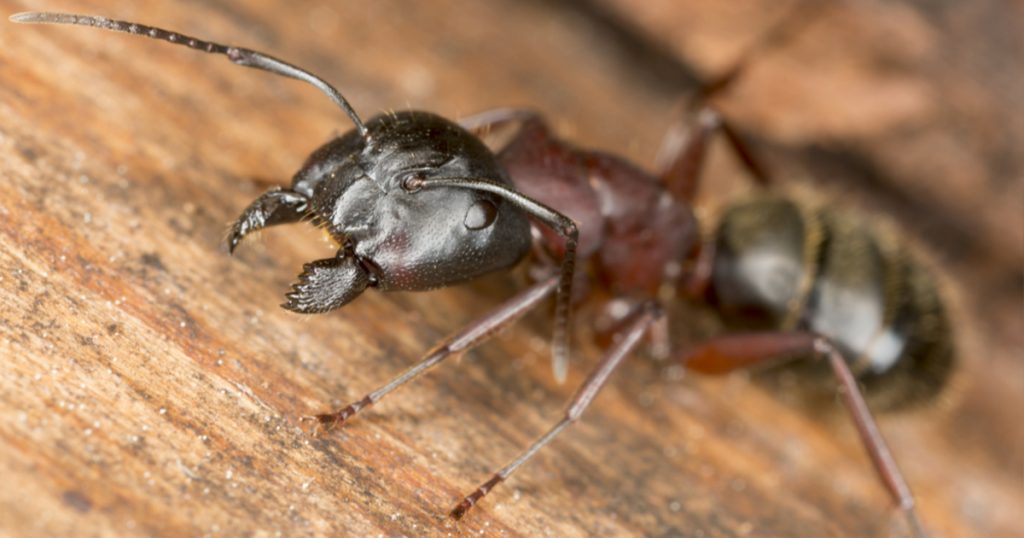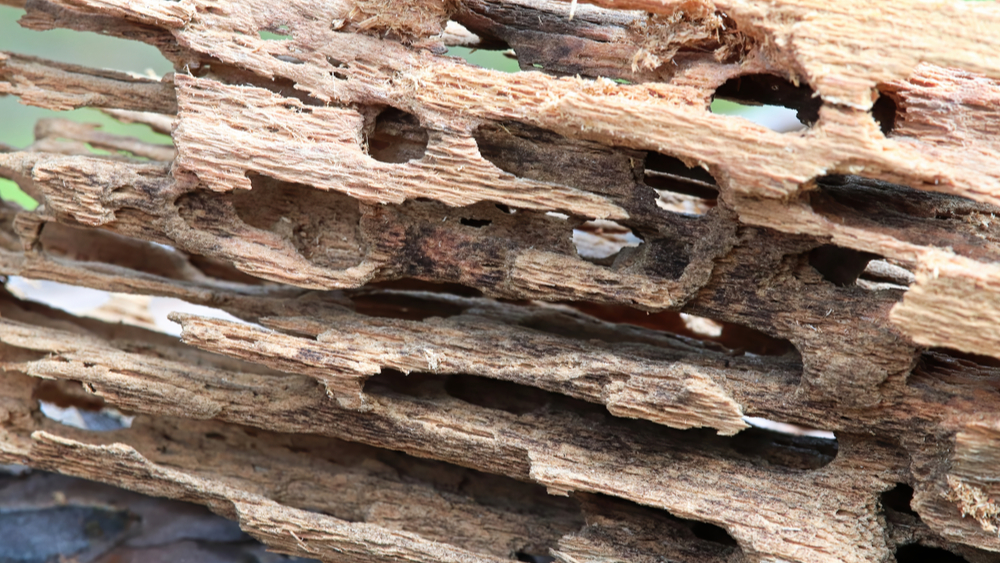
Each spring, Florida carpenter ants produce a mating swarm. This is when the reproductives, females, and males, emerge from a nest, typically in large numbers, to seek out locations for their new nests. While they prefer damp or rotting wood, carpenter ants will also nest in dry, undamaged wood. If carpenter ants settle in your home’s wooden support pillars, window frames, attics, or other wooden structures, the resulting damage can cost thousands of dollars to repair.

People often mistake carpenter ants for termites because the two species are similar in appearance, and both cause wood damage to homes. The two pests, however, differ in significant ways:
- Carpenter ants don’t digest wood the way termites do. Instead, they create channels in the wood that they use for building nests and finding food.
- Carpenter ants have three distinct body sections: head, thorax, and abdomen. By contrast, termites have only a head and thorax.
- The wings of flying carpenter ants, known as alates, are only slightly longer than their bodies, whereas flying termites have wings that are about twice as long as their bodies.
Carpenter ants are adept at evasion—they’re most active at night, and their nests can be difficult to locate. One indication that your home has a carpenter ant infestation is the presence of small piles of sawdust near wooden structures, furniture, or other items. In most instances, it takes a professional pest control technician, such as the pros at Nozzle Nolen, to confirm the presence of carpenter ants and track down their nests.
Signs of a Carpenter Ant Infestation in a South Florida Home
Carpenter ants are most noticeable in South Florida during their swarming season from April to June. During this time, you may find carpenter ants around window sills and doorways. If you do find winged carpenter ants inside your home, it could be a sign of an infestation that began several years earlier. In such cases, your home may have already suffered considerable damage.

Wingless carpenter ants may also invade your home in search of food. They are attracted to a range of vegetables and other insects, especially sweet nectars and honeydews from aphids, mealybugs, and other sucking insects. Carpenter ants also prey on grasshoppers, crickets, caterpillars, and other bugs, but they seek out moisture and sweets inside homes.
Depending when you find carpenter ants in your home matters:
- If you notice carpenter ants in your home only at certain times of the year, their nest is likely located outside the structure. A pest control specialist can follow the ants’ trails back to the nest.
- When you find the small sawdust piles in remote areas, such as crawl spaces, attics, or closets, there’s a good chance the ants are actively carving out channels in your house’s wood structures to create nests and conduits for food sources.
Why Carpenter Ants Are So Difficult to Eradicate
Carpenter ants are one of the most common indoor pests that South Florida homeowners will encounter. Their colonies often expand to include several subcolonies located both outdoors and indoors. Even spotting a few of these pests in your home should be cause for alarm because carpenter ants are experts at staying out of sight. If you spot a handful, there are likely many more scurrying around undetected.
The first step in eliminating a carpenter ant infestation is locating and removing their nests. Doing so, however, can be challenging. When the nests are indoors, the best approach is to watch foraging ants and note where they enter voids or cracks in walls, floors, and other structures. Carpenter ants are most active from sunset until just before dawn. Their trails are loosely defined, making the insects more difficult to track.
The best way to prevent carpenter ants from nesting in your home is to ensure that all of your home’s wood remains dry and undamaged. Fix leaky pipes right away and dry out any areas where moisture accumulates inside and outside the house, such as under bathroom and kitchen fixtures and around outdoor spigots. Also, keep exterior wood from coming into contact with soil or other sources of moisture. Additional tips to keep these pests away include:
- Make sure all stored food is well covered.
- Clean up spills and food traces quickly.
- Cover all trash containers and pet food receptacles.
Keeping carpenter ants and other invading insects out of your house requires patching any cracks or holes in its walls or foundation. Remove any potential outdoor nesting sites, such as tree stumps, broken tree branches, or firewood, which should be stored off the ground and away from your house.
It’s easy to dismiss the sight of a few ants in your kitchen or backyard as nothing more than harmless seasonal foraging, but carpenter ants are relentless. Once they’ve discovered a friendly habitat, they’ll build out their nests for as long as the food supply allows.
Getting Started With Nozzle Nolen
Don’t wait until a small ant problem becomes a major headache. The certified pest control technicians at Nozzle Nolen have the training and experience to find and remove all carpenter ant nests in your home and on your property. The company’s 365 Complete Home Protection Plan provides year-round protection against carpenter ants and dozens of other pests, including termites, rodents, cockroaches, wasps, hornets, and many others. There’s no better way to ensure your house remains pest-free all year.
Nozzle Nolen has been providing expert pest control to the residents of South Florida for more than seven decades. If you suspect you are facing a carpenter ant infestation in your home, give us a call at 800.226.6536 or Contact Us. We look forward to serving you.




